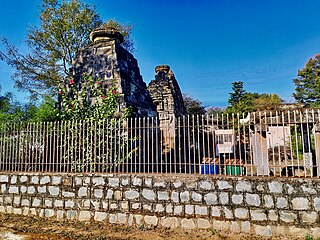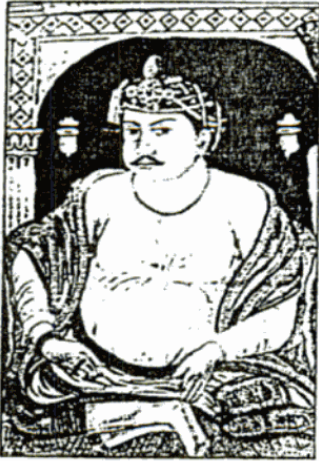Related Research Articles

Basmati is a variety of long, slender-grained aromatic rice which is traditionally grown in the Indian subcontinent, mainly India, and Pakistan, as well as some regions of Sri Lanka and Nepal. As of 2019, India accounted for 65% of the international trade in basmati rice, while Pakistan accounted for the remaining 35%. Many countries use domestically grown basmati rice crops; however, basmati is geographically exclusive to certain districts of India and Pakistan.

Bhandara District is an administrative district in the state of Maharashtra in India. The name Bhandara is a corruption of Bhanara. Reference to Bhanara is found in an inscription of 1100 A.D. traced at Ratanpur. The district headquarters are located at Bhandara. The district occupies an area of 3717 km2 and has a population of 1,200,334, of which 19.48% are urban as of 2011. The growth rate of Bhandara is 5.56% Bhandara has a mixed economy with agriculture, industries and forest resources. Bhandara is known for its large production of rice. Tumsar, a tahsil town, is a noted rice market. Bhandara town is also known as "Brass City" owing to the presence of a large brass products industry. Bhandara has several tourist destinations, like Ambagad Fort, Brahmi, Chinchgad, and Dighori.

Balaghat district is a district of Madhya Pradesh state in Central India. Its belongs to Jabalpur Division. Balaghat city is Administrative Headquarter of Balaghat District.

Wardha District is in the state of Maharashtra in western India. This district is a part of Nagpur Division. The city of Wardha is the administrative headquarter of the district. Hinganghat, Pulgaon, Arvi and Wardha are the major cities in the District. The District had a population of 1,300,774, of which 26.28% were urban as of 2011.

Gondia is a city and headquarters of eponymous Gondia District in Maharashtra, India. Gondia is also known as Rice City due to the abundance of rice mills in the area. Gondia Airport is the only airport in the district.
Ajara is a census town and the headquarters of Ajara Taluka in the Kolhapur district of Maharashtra, India. It is a developing city with a Nagar Panchayat.

Katangi is a city and a municipal council, near the city of Balaghat in Balaghat District in the Indian state of Madhya Pradesh.
Ambemohar is a fragrant rice variant grown in the foothills of the Western ghats region of the state of Maharashtra in India.

Bhandara is one of the 288 Vidhan Sabha constituencies in Maharashtra state in central India. This constituency is one of the three constituencies located in Bhandara district.

The Bilaspur–Nagpur section is part of the Howrah–Nagpur–Mumbai line and connects Bilaspur in the Indian state of Chhattisgarh and Nagpur in Maharashtra. Part of one of the major trunk lines in the country, it passes through a forested plateau region interspersed with fertile valleys.
Gondia Junction serves Gondia in Gondia district in the Indian state of Maharashtra. It is one of the important railway stations in India of South East central railways zone railways. This station is India's third and first in Vidarbha to get mist cooling system.Its falls under nagpur division

Bakht Buland Shah was a ruler of the Rajgond dynasty. He added to his kingdom, the territories of Chanda and Mandla, and portions of Nagpur, Balaghat, Seoni, Bhandara and the adjoining Rajput kingdom of Kherla/Khedla. The present districts of Chhindwara and Betul also fell under his control. A great warrior, he went on to conquer Pauni, Dongartal, Sivni, and Katangi.

Tumsar Road Junction railway station serves Tumsar City and the surrounding area in Bhandara district in Maharashtra, India. The station consists of five platforms. The platforms are not well sheltered. It lacks many facilities including water and sanitation.
Chokuwa saul is a variety of semi-glutinous rice found in Assam, India. The sticky rice of Assam is traditionally classified as bora (glutinous) and chokuwa (semi-glutinous) based on their stickiness after cooking. It has an important role in Assam.
Ajara Ghansal is a variety of non-Basmati aromatic rice mainly grown in the Indian state of Maharashtra. It is a common and widely cultivated crop in Ajara taluka of Kolhapur district.
Balaghat Chinnor is a variety of non-Basmati aromatic rice mainly grown in the Indian state of Madhya Pradesh. It is a common and widely cultivated crop in tehsils of Balaghat, Baihar, Birsa, Paraswada, Katangi, Waraseoni, Lalbarra, Khairlanji, Lanji and Kirnapur of Balaghat district
Uttarakhand lal chawal is a variety of non-Basmati, aromatic, red colored rice mainly grown in the Indian state of Uttarakhand. This rice variety is grown in the high-altitude regions of Uttarakhand. It is a common and widely cultivated crop in Purola, Mori, and surrounding areas in Uttarkashi district.
Adamchini Chawal is a variety of non-Basmati, traditional, short-grained aromatic rice mainly grown in the Indian state of Uttar Pradesh. It is a common and widely cultivated crop in Chandauli, Mirzapur, Varanasi and Sonebhadra, and Vindhya region of Eastern Uttar Pradesh.
Chak-Hao is an indigenous, aromatic, glutinous, and large-grained black rice variety mainly grown in the Indian states of Manipur and Nagaland. It is a common and widely cultivated crop in the districts of Imphal East, Imphal West, Bishnupur, Thoubal of Manipur and Peren district of Nagaland. Chak-Hao or Chakhao or Chak Hao Amubi are variations of the same name. It is popularly called the Black rice of Manipur or Manipur Black rice.
Jeeraphool rice is an ancient, indigenous, aromatic, and short-grained rice variety mainly grown in the Indian states of Chhattisgarh. It is a common and widely cultivated crop in Surguja district of Chhattisgarh in Ambikapur, Lakhanpur, Udaipur, Sitapur, Batauli, Lundra and Mainpat. The uniqueness is that the shape of the rice grain is shaped like a cumin.
References
- ↑ Gahane, A. S.; Atkare, V. G.; Wankhade, Bhavana R. (2024). "Studies on sensory evaluation of Bhandara chinnor rice (Oryza sativa) Kheer". International Journal of Veterinary Sciences and Animal Husbandry. 9 (5S): 39–41. ISSN 2456-2912 . Retrieved 22 November 2024.
- ↑ Kanga, Shruti; Meraj, Gowhar; Singh, Suraj Kumar; Farooq, Majid; Nathawat, M. S. (13 November 2024). Geospatial Technology for Natural Resource Management. John Wiley & Sons. ISBN 978-1-394-16636-7.
- ↑ Srivastava, Anvita (26 April 2020). "Bhandara Chinnor rice to get a GI-tag for its farmers". The Bridge Chronicle. Retrieved 22 November 2024.
- ↑ "पूर्व विदर्भातील चिन्नोर तांदूळ जाणार जागतिक बाजारपेठेत". Lokmat (in Marathi). 17 March 2020. Retrieved 22 November 2024.
- ↑ "A CASE STUDY OF RICE MILLING CLUSTER OF BHANDARA DISTRICT (MS)". ResearchGate GmbH. Retrieved 22 November 2024.
- ↑ "Putting their name on grain of rice". The Times of India. 9 November 2012. Retrieved 22 November 2024.
- ↑ "A CASE STUDY OF RICE MILLING CLUSTER OF BHANDARA DISTRICT (MS)". ResearchGate GmbH. Retrieved 22 November 2024.
- ↑ Agriculture, Bombay (State) Department of (1956). Report. Yeravda Prison Press. Retrieved 22 November 2024.
- ↑ "Connecting Maharashtra to the World" (PDF). MAHARASHTRA INDUSTRY, TRADE AND INVESTMENT FACILITATION (MAITRI). Retrieved 22 November 2024.
- 1 2 "GOVERNMENT OF INDIA GEOGRAPHICAL INDICATIONS JOURNAL NO. 158 JULY 15, 2022" (PDF). Intellectual Property India. Retrieved 22 November 2024.
- ↑ Prasad, Rajendra. Current Affairs Year Book 2022: Geography. MYUPSC. Retrieved 22 November 2024.
- ↑ Provinces (India), Central (1907). Central Provinces District Gazetteers. Printed at the Pioneer Press. Retrieved 22 November 2024.
- ↑ News, Nagpur (24 July 2024). "Flooding Shuts Down Bhandara-Tumsar-Balaghat Road, Cutting Maharashtra-MP Link". Nagpur Today : Nagpur News. Retrieved 22 November 2024.
{{cite news}}:|last1=has generic name (help) - ↑ India, Govt Of; House, Print (1996). Races of Rice in India. M.D. Publications Pvt. Ltd. ISBN 978-81-85880-91-4 . Retrieved 22 November 2024.
- ↑ Dept, Maharashtra (India) Buildings and Communications (1965). Maharashtra Motor Guide, 1965. Printed at the Government Central Press. Retrieved 22 November 2024.
- ↑ Dogra, Bharat (1991). The Life and Work of Dr. R.H. Richharia: The Eminent Rice Scientist who Struggled All His Life for Small Farmers to Protect Them from Big Business and to Preserve Their Heritage : Including the Text of an Action Plan on Rice Prepared by Dr. Richharia. B. Dogra. Retrieved 22 November 2024.
- ↑ "Studies on sensory evaluation of Bhandara chinnor rice (Oryza sativa) Kheer" (PDF). International Journal of Veterinary Sciences and Animal Husbandry. Retrieved 22 November 2024.
- ↑ "How a GI tag could resuscitate a near-dead variety of rice in MP". India Today. 14 October 2021. Retrieved 22 November 2024.
- ↑ Nadaf, Altafhusain; Mathure, Sarika; Jawali, Narendra (15 December 2015). Scented rice (Oryza sativa L.) Cultivars of India: A Perspective on Quality and Diversity. Springer. ISBN 978-81-322-2665-9 . Retrieved 22 November 2024.
- ↑ वृत्तसेवा, सकाळ (20 December 2019). "भिवापुरी मिरची, नागपूरची संत्री, आता चिन्नोर तांदूळ बनेल ब्रॅंड". Marathi News Esakal (in Marathi). Retrieved 22 November 2024.
- ↑ "One District One Product Bhandara | District Bhandara, Government of Maharashtra | India". District Administration © Copyright District Bhandara. Retrieved 22 November 2024.
- ↑ "Maharashtra". Agricultural and Processed Food Products Export Development Authority (APEDA). Retrieved 22 November 2024.
